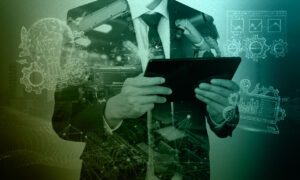Editor’s Note: Professor Luo Laijun, a Chinese scholar, spent about 30 years observing the economic practices of countries around the world and founded the Actual Effect Economics (AEE). In the article “The Ninth Economics Revolution and the Theoretical Revision of Existing Economics by a Chinese Scholar”, it’s pointed out that “In the current situation it’s hard to break through the development of global economics, AEE founded by Chinese scholar Luo Laijun has put forward original ideas in basic economic theories. It’s a step forward compared to previous economic theories and can make certain revisions and improvements to existing economics. It’s definitely worthy of being called another revolution in the development of basic economic theories, that is, the Ninth Economics Revolution in the world.” Centering on the theme of the Ninth Economics Revolution, our newspaper conducted an exclusive interview with Professor Luo.
Reporter: There are so many scholars around the world, but those who come up with a new economic theory are really few. How did you get the idea to create one economic theory like AEE?
Luo Laijun: In that article “The Ninth Economics Revolution and the Theoretical Revision of Existing Economics by a Chinese Scholar” you mentioned, there’s a passage saying “Nowadays, in the economic development of many countries and regions, there are a lot of problems that make the economic development inefficient. So, it’s really timely to call AEE and its influence the ‘Actual Effect Revolution’. Proposing this ‘revolution’ is to remind and stress to countries around the world that during their economic construction they should focus on economic actual effects and avoid economic problems like waste, loss, and negative impacts.” That’s exactly why I came up with AEE to avoid those inefficient economic problems.
I first thought about creating an economic theory when I was in college. I majored in economics at Peking University. Back then, the teacher talked about how previous people created economic theories, and that inspired me. I also wanted to create one myself. It was just a simple thought at that time, and I didn’t take any action. After graduating from college, I realized there were so many economic problems in reality. So, I started observing the economic practices of different countries, trying to come up with an economic theory to prevent, avoid, and solve these problems. Since then, I’ve been working on creating this theory, observing real-world economic problems while building and proving the theory.
Reporter: Compared with the existing mainstream economics in the world, what are the main theoretical innovations of AEE?
Luo Laijun: I often talk with other scholars about AEE to keep improving it. Based on my own thinking and what we’ve discussed, I’ll share three main theoretical innovations.
First, the basic paradigm of AEE: “Actual Effect = Receiver Benefit – Input & Consumption – Involved Impact” is proposed. And with this, a relatively complete economic theory has been developed. Traditional economics usually analyzes individual objects separately. But AEE’s basic paradigm breaks this separation. It looks at the overall flow of resources and takes into account all relevant factors of human economic activities, including both positive and negative impacts. It’s a more objective and scientific way. People even call this paradigm the “General Economic Formula”, which is compared with Keynes’ “General Formula of Economics” (GDP = Consumption + Investment + Net Export).
Second, the greatest theoretical innovation and the greatest practical contribution of AEE are considered to be the proposal of Receiver Benefit, that is, the actual benefit in the consumption and use links. This is different from corporate benefit. For example, when a company sells its products, corporate benefits are generated. If these products are not consumed or used by people, the receiver benefit is zero. This is a direct breakthrough in traditional economics. Scholars have proposed the “Smith | Marshall – Luo Laijun” framework: Smith’s “division of labor and specialization” and Marshall’s “resource allocation” both point to economic output, while Luo Laijun’s “receiver benefit” points to the fact that the output is meaningful only when it is consumed or used by people. The paradigm of AEE proposes that receiver benefit has taken another step forward from the paradigms of Smith and Marshall, and also taken another step towards the essence of the economy. This theoretical logic is called the “people-centered economic paradigm”.
Third, AEE has broken through the “Profit Maximization” theory, which is most common in global mainstream economics and also in actual practices, and has improved and developed it into “Actual Effect Maximization”. When profit maximization and actual effect maximization are inconsistent, it indicates that there are ineffectiveness problems. It is necessary to find the causes and carry out governance at the four levels of enterprises, the market, consumption, and the government to promote corporate behavior to conform to actual effect maximization. At this time, actual effect maximization and profit maximization are consistent. This theoretical innovation integrates micro- and macro- economics organically, overcoming the logical flaw of the disconnection between micro- and macro- economics in existing economics.
By the way, I want to tell you something really interesting. I once talked with some primary school students about Einstein’s theory of relativity. The kids said it is wrong and there are a lot of problems with it. I guess they said that based on their intuition. For example, in relative motion, it’s hard to tell if an object is stationary or moving. If you can’t figure this out, then you can’t tell the state of any object. So, how can we make sense of the world? During our discussion, we came up with the Theory of the Third Reference. With this theory, we can tell if an object is stationary or moving. This theory got a lot of praise and people said it was better than the Theory of Relativity in terms of cognitive logic. So far, there are three major physical logics: the Theory of Absoluteness, the Theory of Relativity, and the Theory of the Third Reference (also called “the Theory of Relative Absoluteness”). I applied the logic of this theory to the field of economic theory to judge the pros and cons of economic things. I’m not sure if it makes sense in the scientific field, but it’s really useful for making judgments in economic field.
Reporter: Theories need to be tested in practices. Is AEE reliable in practical applications? Does it have any advantage?
Luo Laijun: When people talk about the “Actual Effect Revolution”, they don’t just focus on the theory. They care more about its practical applications. For example, the idea of different types of economic growth (from the third type to the seventh type) proposed by AEE has inspired the economic development of many countries. In terms of practical applications, people have given positive feedback: It’s really rare for an economic theory to have successful practical applications so soon after it’s created. I’ll share one example here.
This example is from Chinese airlines. We analyzed from the perspective of AEE that when passengers have meals on the plane, there are usually forks, knives, and spoons. But people usually only use one of them, mostly forks or spoons. It’s a waste to prepare all three. It’s enough to just prepare one fork or spoon. China Southern Airline made an improvement and created the ‘Spork’, which is like a spoon with some parts at the end looking like a fork. Now, flights only provide one ‘Spork’, saving two-third of the materials and labors. This innovation spreads really fast among Chinese airlines. In just over two years, most flights only provide one Spork. Even some foreign airlines, like those in South Korea, have started using it.
In addition, AEE also has a major feature, which is the development of a series of economics test questions based on AEE theory and practices. These questions not only present the practical application of AEE, but also demonstrate the difference between AEE and existing economics through direct comparison with existing theories.
Reporter: So, can you provide an example for the test questions of AEE?
Luo Laijun: For example, the following question:
According to world popular science materials, as early as around 1920, light-bulb manufacturers could produce light bulbs that could work for more than 2,500 hours. But later, the lifespan of light bulbs didn’t get longer. Instead, it got shorter, and the average working time gradually dropped to about 1,000 hours. This wasn’t because of technology limitations. It was because people deliberately “controlled” the usage time of light bulbs. Now, here are some questions:
(1) AEE has broken through the “Profit Maximization” theory, which is the most common in global mainstream economics and also in actual practices, and has improved and developed it into “Actual Effect Maximization”. Then, taking the light bulb lifespan of 1,000 hours and 3,000 hours respectively (assuming the total cost is 26 yuan and the selling price is 38 yuan for both), calculate and illustrate the difference between Profit Maximization and Actual Effect Maximization;
(2) How can we make manufacturers produce in a way that maximizes actual effects? Why? What is the theoretical basis of AEE?
(3) AEE has overcome the logical flaw of the disconnection between micro- and macro- economics in traditional economics. Please prove this using this example.
(4) Some scholars call AEE the economics of real objects or real economics. Please prove this using this example.
Due to space limitation, only the answers to (1) and (3) are provided for reference:
(1) Let’s use the lifespan of light bulbs as a measure of receiver benefit. Multiply it by a coefficient X yuan to turn it into a monetary value. So, the receiver benefits of light bulbs with lifespans of 1,000 hours and 3,000 hours are 1,000X yuan and 3,000X yuan respectively. Using the simplified formula “Actual Effect = Receiver Benefit – Input & Consumption”, the actual effects of using one light bulb of each lifespan is (1,000X – 26) yuan and (3,000X – 26) yuan. For a total of 3,000 hours of use, we need 3 light bulbs with a short lifespan. It’s profit is (38 – 26) × 3 = 36 yuan. For a long-lifespan light bulb, we only need 1, and the profit is 38 – 26 = 12 yuan. The difference in actual effects is (1,000X – 26) × 3 – (3,000X – 26)= – 52 yuan. Three short-lifespan light bulbs earn more 24 yuan than a long-lifespan light bulb for the same usage duration, which is three times the profit. However, the actual effects is reduced by 52 yuan. Short-lifespan light bulbs represent Profit Maximization, while long-lifespan light bulbs represent Actual Effect Maximization.
(3) The behavior of manufacturers to maximize profit is a common economic practice at the micro level. But this leads to a kind of ‘Destructive-Type Growth’ at the macro level. For example, in an output value of 11.4 billion yuan, 5.2 billion yuan of input can be saved according to the technology, but it is destructed because people deliberately “control” the usage time of light bulbs. This shows that AEE integrates micro- and macro- economics organically, overcoming the logical flaw of their separation in traditional economics.
Reporter: What impact will AEE have on the development of the world economy?
Luo Laijun: AEE was founded based on observing the world economy and the economic practices of different countries. It can offer useful references for the development of the world economy and individual national economies. Let me give you a specific example.
Wei Jiafu, the former chairman of China Ocean Shipping (Group) Company, has been to many countries and participated in a lot of international affairs. He is well-versed in global affairs. Based on his global experiences, he proposed that this theory, which changes traditional global thinking and evaluation methods, should be implemented in practices. He suggested to formulate the Ten Principles of AEE for Enterprises, aiming to turn them into the United Nations’ Ten Principles of AEE for Enterprises and incorporate them into the United Nations’ regulations, so as to contribute to more regions and enterprises around the world.
We’ve already drafted the Ten Principles of AEE for Enterprises and are currently seeking opinions from various parties to improve them. The Ten Principles show that AEE is quite different from current mainstream economics. But it can better guide enterprise practices, leading to high-quality, inclusive, and beneficial economic development, and deeply implementing the people-centered development philosophy proposed by Chinese President Xi Jinping. Therefore, we made these ten principles for enterprises around the world to refer to. For example, Principle 1: Enterprises should pursue actual effect maximization instead of profit maximization that strays from it. Principle 2: Enterprises should strive for maximization of receiver benefit rather than profit maximization at the expense of consumers’ interests. Principle 3: Enterprises should aim for minimization of input & consumption and actively promote the development of a conservation-oriented actual-effect-type economy (AET economy). Principle 4: Enterprises should seek to minimize involved impacts and avoid ignoring negative impacts for the sake of profit. Each principle explains the difference between AEE and existing economics, as well as gives practical guidance and suggestions.



































